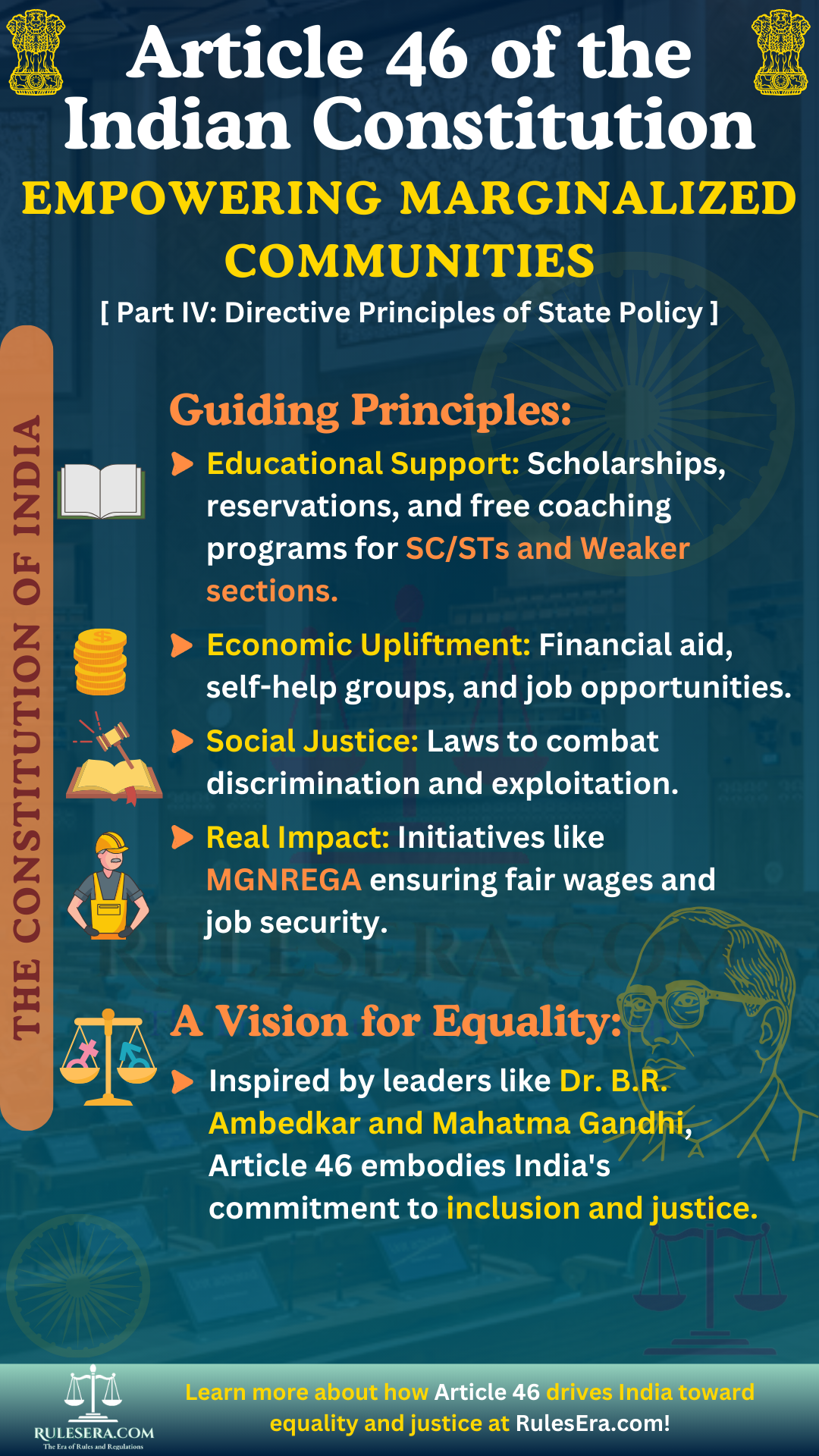Part IV: Directive Principles of State Policy
Article 46: Promotion of educational and economic interests of SCs, STs, and other weaker sections

--- Original Article ---
The State shall promote with special care the educational and economic interests of the weaker sections of the people, and, in particular, of the Scheduled Castes and the Scheduled Tribes, and shall protect them from social injustice and all forms of exploitation.
Explanation
Article 46 of the Indian Constitution is designed to safeguard and uplift the Scheduled Castes (SCs), Scheduled Tribes (STs), and other weaker sections. The State is entrusted with promoting their educational and economic interests, while also protecting them from exploitation and social injustices.
Educational Empowerment of SCs, STs, and Weaker Sections
The State is tasked with creating and implementing educational policies that offer SCs, STs, and weaker sections access to quality education. This includes affirmative action such as reservations in educational institutions and scholarships.
Economic Upliftment
Article 46 emphasizes the need for economic empowerment through targeted programs. The State provides financial assistance, training, and employment initiatives to improve the economic conditions of SCs, STs, and other weaker sections.
Safeguarding from Exploitation
Article 46 mandates the protection of SCs, STs, and weaker sections from economic and labor exploitation. This includes legal provisions that prevent exploitative practices in employment, wages, and financial transactions.
Amendments and Legislative Developments
Although Article 46 remains unamended, several policies have been introduced to strengthen its objectives. The creation of the National Commission for Scheduled Castes and the National Commission for Scheduled Tribes reflects the ongoing efforts to monitor the welfare of these communities.
Real-Life Examples
- Self-Help Groups (SHGs): In rural areas, SCs and STs have benefited from government-supported SHGs, which provide opportunities for self-employment and economic upliftment.
- Free Coaching Schemes: The State has implemented free coaching programs to help SC/ST students prepare for competitive exams, directly addressing the educational component of Article 46.
- MGNREGA: The Mahatma Gandhi National Rural Employment Guarantee Act (MGNREGA) provides job security and fair wages to marginalized communities, aligning with the goals of Article 46.
Historical Significance
Article 46 addresses the historical injustices faced by SCs and STs. It was inspired by social reform movements led by leaders like Mahatma Gandhi and Dr. B.R. Ambedkar, who fought for the upliftment of these communities.
Legislative History
Article 46, originally introduced as Article 37 of the Draft Constitution, was debated on November 23, 1948 and later adopted in its current form in the final Constitution.
Debates and Deliberations
During the Constituent Assembly debates on November 23, 1948, Sardar Hukum Singh (East Punjab: Sikh) proposed an amendment to replace the term "Scheduled Castes" with "Backward communities of whatever class or religion." He argued that backward Sikh communities shared the same socio-economic disadvantages as Scheduled Castes, yet were not provided the same benefits, leading to frustration and conversions. His amendment aimed to ensure that all backward communities, regardless of religion, would benefit from the provisions of Article 46.
Shri A.V. Thakkar supported Singh’s proposal and emphasized the importance of including backward classes among Hindus and Muslims as well. However, Dr. B.R. Ambedkar suggested that such amendments related to backward classes would be more appropriate for discussion in the schedule of the Constitution. As a result, Sardar Hukum Singh and Shri A.V. Thakkar withdrew their amendments, leaving the focus of Article 46 specifically on Scheduled Castes and Scheduled Tribes.
Dr. Ambedkar also defended the necessity of Article 46, highlighting the historical disadvantages faced by these communities. He explained that the intent of the article was not to exclude other backward classes but to give special consideration to Scheduled Castes and Scheduled Tribes due to the extent of the discrimination they had faced over centuries. Ultimately, the article was passed as originally drafted, focusing on promoting the educational and economic interests of these specific groups and protecting them from exploitation and social injustice.
Frequently Asked Questions (FAQs):
Article 46 focuses on promoting the educational and economic welfare of Scheduled Castes, Scheduled Tribes, and other weaker sections, and protecting them from exploitation and social injustice.
Laws like the Scheduled Castes and Scheduled Tribes (Prevention of Atrocities) Act, 1989 and initiatives like MGNREGA support the goals of Article 46 by providing protection and opportunities to marginalized communities.
Protection from Social Discrimination
The State is responsible for ensuring that SCs, STs, and other weaker sections are shielded from caste-based discrimination. Legislative measures like the Scheduled Castes and Scheduled Tribes (Prevention of Atrocities) Act, 1989 aim to protect these communities from social injustices.